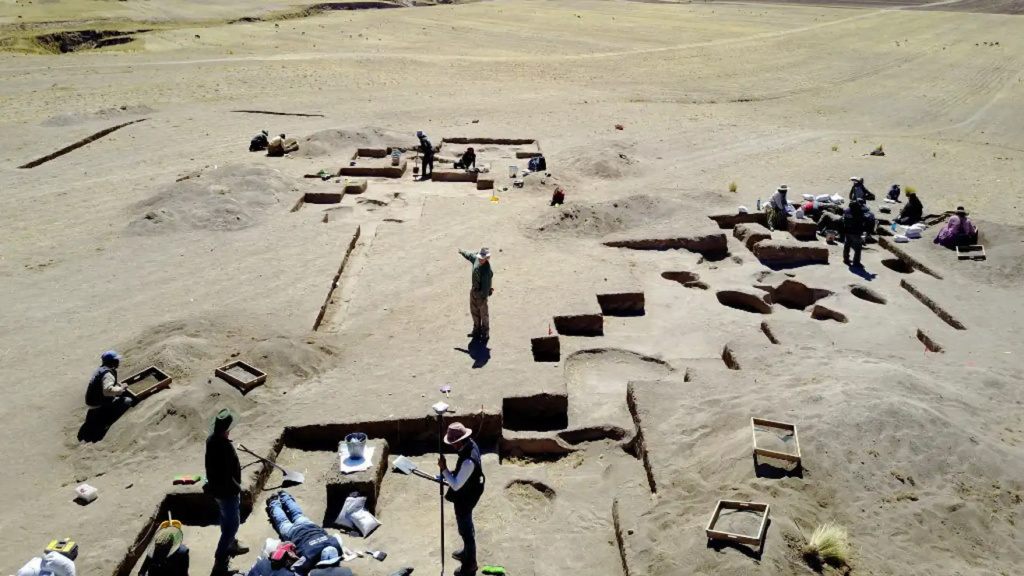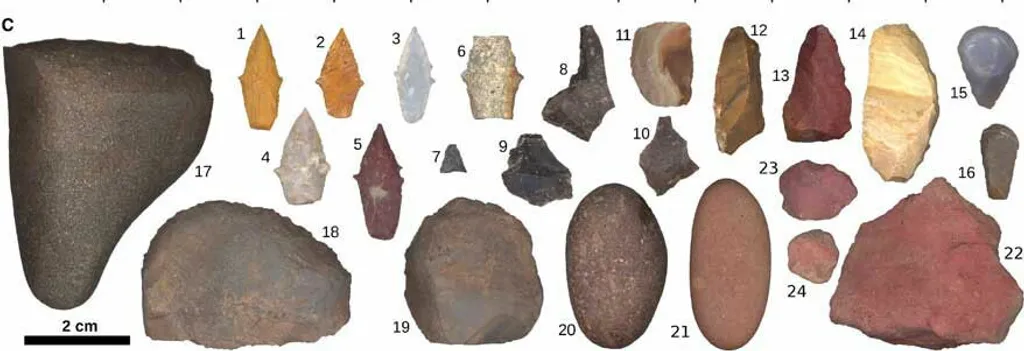This prehistoric hunter who died 9,000 years ago was a woman

Artistic depiction of a hunting scene in the Andes, South America, 9,000 years ago. Archaeologists believe the hunter wore leather clothing tanned with red ocher from the set of tools found in the tomb.
While many researchers still believe that prehistoric men hunted when women gathered and cared for children, this assumption is challenged by this recent discovery.
In 2018, Randall Haas , an archaeologist at the University of California, and his team of researchers gathered around the grave of an individual buried 9,000 years ago in the Andes, Peru. In addition to the bones that seemed to belong to an adult man, the burial also housed an important and impressive set of stone tools, which the hunter probably used to kill big game or take the skin of the animal.

“He must have been an excellent hunter, a very important person in society,” thought the archaeologist and his team when unearthing the tomb.
A closer analysis of the bones found alongside these tools, however, revealed a surprise: they belonged to a woman. And this hunter would not be an exception according to a study published in the journal Science Advances . The discovery by Randall Haas' team was the starting point for a study of previously studied graves from the same period across the Americas, which concluded that between 30 and 50 percent of big game hunters may have been women.
The new study is the latest twist in a decades-long debate over gender roles in early hunter-gatherer societies. It is widely assumed that prehistoric men hunted while women gathered plants and raised their children. But, for several decades, some researchers have argued that these “traditional” roles would not necessarily be valid in our distant past, based in particular on the observations of groups of hunter-gatherers by anthropologists around the world since the 19th century .
If the new study offers new arguments proving that this hunter was in fact a hunter, a wealth of evidence already existed, said Pamela Geller , an archaeologist at the University of Miami who was not involved in the study.

The set of tools unearthed in the tomb consists of spikes, heavy stones for breaking bones or removing hides, shards for scraping and cutting, and nodules of red ocher for preserving hides.
“The data exists,” she continues. "The question is how researchers interpret them."
THE TOOLS OF A HUNTER
While unearthing the tomb, archaeologists discovered a colorful set of 24 stone tools, including spikes for slaughtering a large mammal, heavy stones for breaking bones or removing skins, small rounded pieces of stone for scraping fat from skins, small shards with very sharp edges for cutting meat and nodules of red ocher for preserving skins. Fragments of animal bones, including distant relatives of the llama and deer, were scattered around the site.
When first discussing the set of tools, scholars assumed that they belonged to a man, presumably a prominent figure, or even a leader of the group. “I am as guilty as the others,” confides Randall Haas, who has worked in the region since 2008. But, back in the laboratory, a careful examination of the bones revealed that they belonged to a woman. To confirm this result, the scientists analyzed a protein that forms tooth enamel and can identify an individual's gender.
More importantly, if the team cannot determine the sexual identity of the individual, they can know their biological sex ( which, like gender, does not always exist in binary terms ). So that means they can't know if the individual lived their life 9,000 years ago in a way that would identify them within their society as female.

AN IMPORTANT CHALLENGE
The 2018 discovery challenges the binary conception of gender among our earliest ancestors: men hunted and women gathered. This hypothesis has its origins in studies of modern hunter-gatherer societies, in which men are more often responsible for hunting, while women mainly take care of children, points out Kim Hill of Arizona State University, an evolutionary anthropologist who was not involved in the study . "You can't dump everything for a crying baby when you're stalking a deer," he wrote in an email.
Inferences made from modern hunter-gatherer populations have limitations, however. Pamela Geller explains that some archaeologists have considered this very simplistic view of male hunters and female gatherers for decades to be an oversimplification. “With few exceptions, and no matter what continent they work on, researchers studying hunter-gatherer groups assume that the gender-based division of labor was universal and rigid,” she explains. "And since that makes sense, they had great difficulty explaining why the skeleton of female individuals showed marks of struggle or hunting or why these people were buried with hunting tools as grave goods."
“They usually don't say anything, as if ignoring the evidence will make it disappear,” says the archaeologist.
The hunt arguably required as many healthy adults as possible for the activity to be safer and more effective, and the biological sex of the participants must have been of little importance. Kathleen Sterling , an archaeologist at Binghamton University who was not involved in the study, explains that mothers could help with big hunts once their children were weaned or when they weren't, if the community looked after said babies.
A DEBATE WITH CONSIDERABLE IMPACTS
Encouraged by their 2018 discovery, Randall Haas's team combed through reports of previous hunter-gatherer excavations across the Americas. Many past studies have uncovered the presence of stone hunting tools in women's graves, but not all cases are unequivocal: sometimes gender cannot be determined, troubled contexts make it unclear whether stone tools and individuals' bodies were buried at the same time, or whether the few projectiles excavated from the grave were murder weapons buried with their victims.

However, when reviewing the individual cases as part of a larger data set, Randall Haas's team found that out of 429 graves, 27 contained an individual of known sex buried with hunting implements, of which 11 were female (recently identified remains included) and the remaining 16 were male. Many uncertainties, such as troubled context and gender identification, surround the graves of men and women, says Randall Haas. Therefore, the number of women buried with hunting tools is similar to that of men, even when most cases considered uncertain are excluded.
"These trends are absolutely not what you would expect in a population if men were [the only ones] hunting," says the archaeologist.
Kim Hill of Arizona State University says she's not entirely convinced the woman buried 9,000 years ago was a hunter. According to him, grave goods such as hunting tools could have been placed in his grave due to symbolic or religious beliefs.
So, did the newly unearthed set of tools belong to the buried person? That's the question Kathleen Sterling asks herself. "Usually we don't ask ourselves this question when we find these objects in human graves," she says. “We only ask ourselves it when it challenges our ideas about sex. »
"Trying to explain these things takes a lot of mental gymnastics ," says Pamela Geller.
The tools discovered in the tomb in Peru were quite diverse: points that were complex to manufacture, as well as more ordinary equipment, such as shards, which were easily shaped by breaking stones. According to Randall Haas, this seems to indicate that the tools were not a kind of offering, but rather that they were objects used during his lifetime by the buried person. Kathleen Sterling also highlights the importance of numbers, as many women have been found buried with tools across the Americas.
Pamela Geller believes that the debate has far-reaching implications for our times. “The gender disparity is so significant today. If we come to assume that something biologically predisposes us, that would justify it,” she says. "This is, in my view, dangerous and absolutely unfounded."
Source : websites

